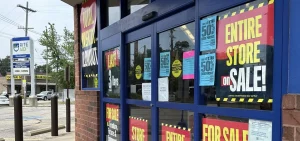News
Pharmacies are closing across the state. What does that mean for Ohioans?
By: Erin Gottsacker | The Ohio Newsroom
Posted on:
CINCINNATI (The Ohio Newsroom) — Pharmacy chain Rite Aid has closed more than a hundred stores in Ohio after it filed for bankruptcy last fall. Walgreens and CVS are shuttering stores across the state too, leaving more and more Ohioans without quick access to local pharmacies.
According to data from TelePharm, a Cardinal Health company, 15 communities in Ohio are now pharmacy deserts, meaning they’re located 10 or more miles away from a retail pharmacy.
Those communities aren’t alone. A recent study by Ohio State University researchers found almost half of all U.S. counties have at least one pharmacy desert.
“Come to find out, it was pretty common,” said Dr. Timothy Pawlik, a senior author of the study. “That kind of surprised us.”
When the researchers looked at the data closer, they found not all communities are impacted by pharmacy closures equally.
Where are pharmacy deserts occurring?
“This was not random where these pharmacies were closing,” Pawlik said.
He and his colleagues compared the locations of pharmacy closures with two factors: social vulnerability (a measure used to assess variables like infrastructure in a community) and the number of primary care providers practicing in the area.
“What we noted was that patients who lived in high social vulnerability areas were at an increased risk of living in a pharmacy desert,” Pawlik said. “And similarly, patients who lived in low density areas with fewer primary care providers were also at a higher risk of living in a pharmacy desert.”
And the differences weren’t slight, Pawlik said. People who lived in areas without many primary care providers were more than twice as likely to live in a pharmacy desert.
That widens the gap in vulnerable communities’ access to health care.
The impact of pharmacy closures
The primary role of pharmacies is to dispense medication, but many do much more. They screen for sicknesses like COVID and distribute flu vaccinations. Some people use services like MinuteClinics as their first site of care.

Many of these patients have chronic conditions, Pawlik said, like diabetes and hypertension. Without nearby pharmacies or primary care providers, they’re less likely to comply with a doctor’s recommendations.
“Not because you’re a difficult patient,” he said. “You literally just can’t get the meds that you need. And so that can exacerbate chronic medical conditions, which is obviously somewhat concerning because this is already happening in vulnerable areas that don’t have primary care physicians. Then they can’t get their medications. And so, it’s kind of like pouring gas on a fire.”
Possible solutions
As physical pharmacies close, one proposed solution is to turn to telehealth and mail order medications. But these alternatives don’t work for everyone, Pawlik said.
People in especially remote areas don’t always have high speed internet. And vulnerable populations often rely on cash, rather than credit, which is necessary to purchase medicine online. Plus, someone without a permanent address might not have anywhere to send their mail order medications.
“Also, ordering medications really misses the input of the pharmacist, and many patients need to talk to their pharmacist to understand how to take the medications and perhaps any side effects they’ve been having,” Pawlik said.
“So, the most vulnerable people may not be able to adequately access telehealth options.”
Perhaps some communities will turn to mobile pharmacies like they have mobile mammograms, Pawlik brainstormed.
The solutions won’t come easy, but as more pharmacies close, they’re increasingly necessary.
“We need to have a really thoughtful approach to how we’re going to address this gap in health care for so many Ohioans and Americans,” he said.

